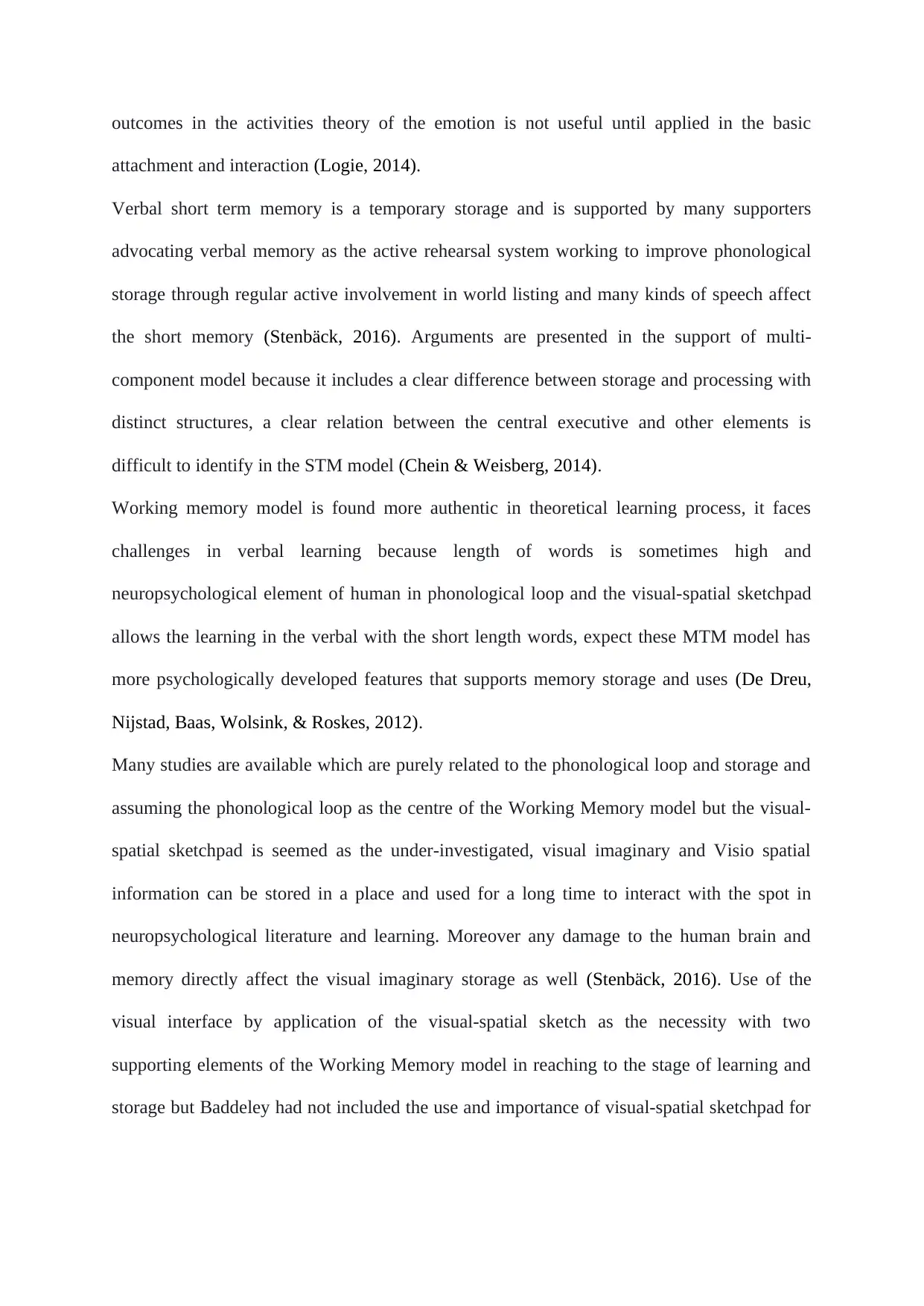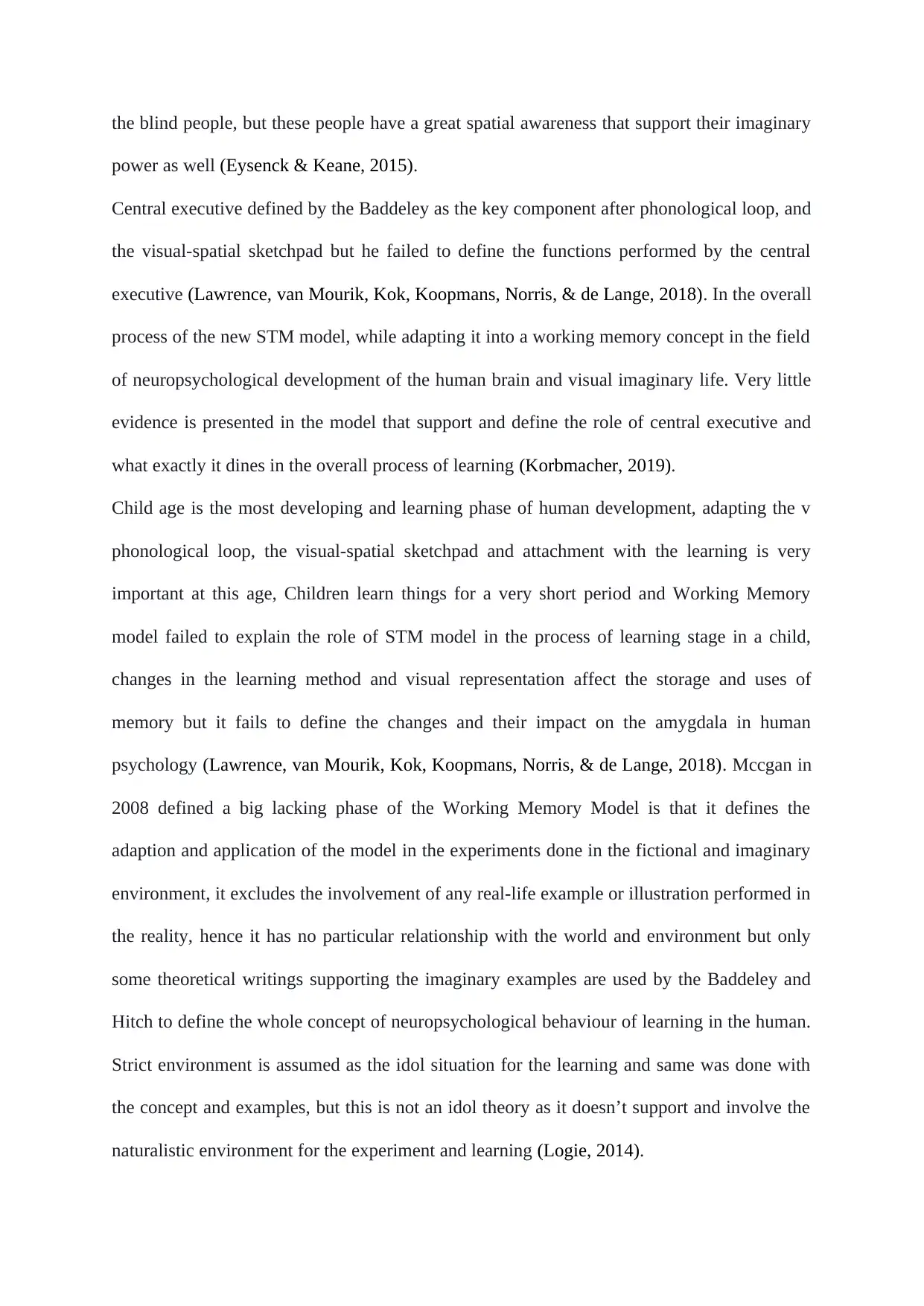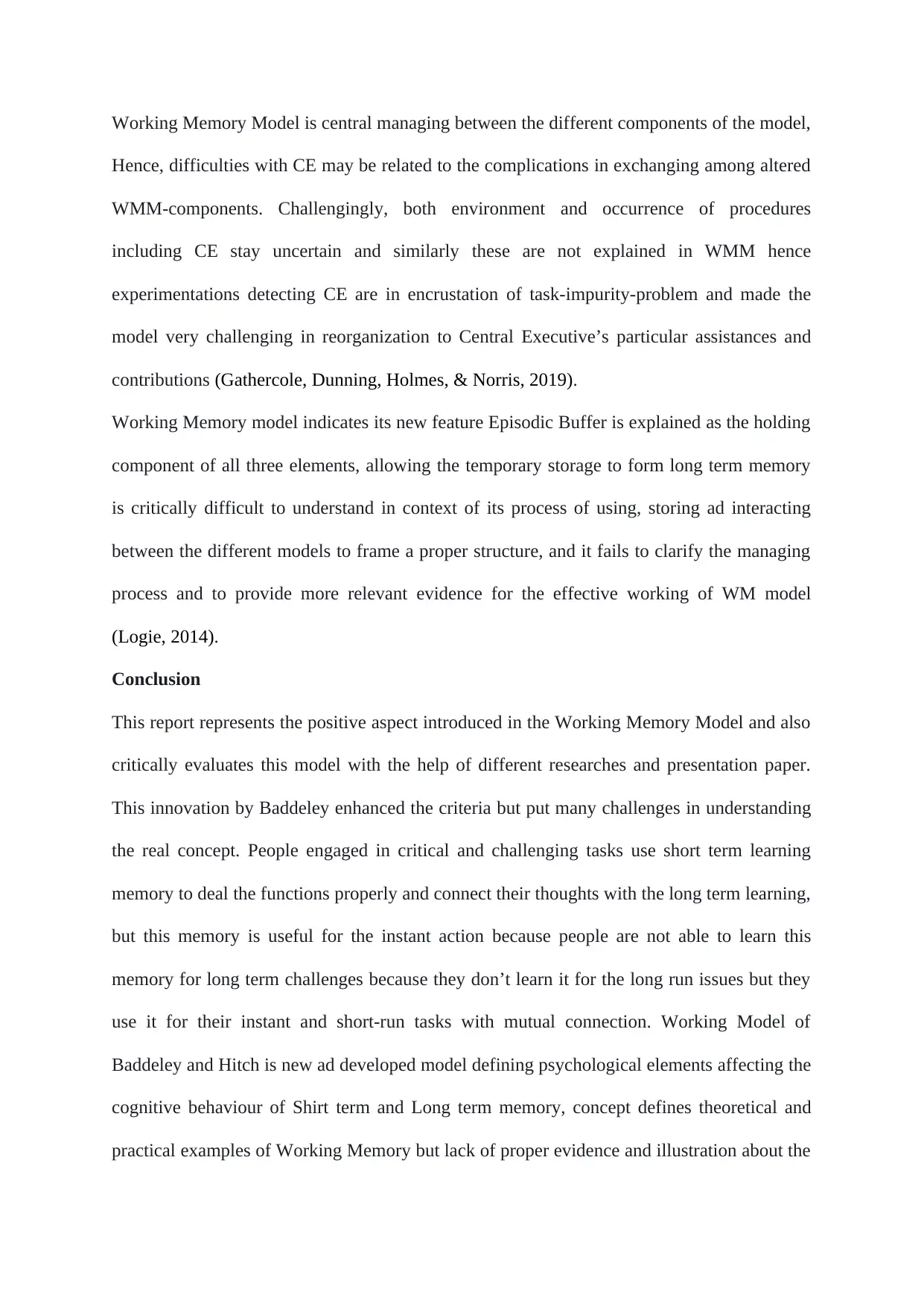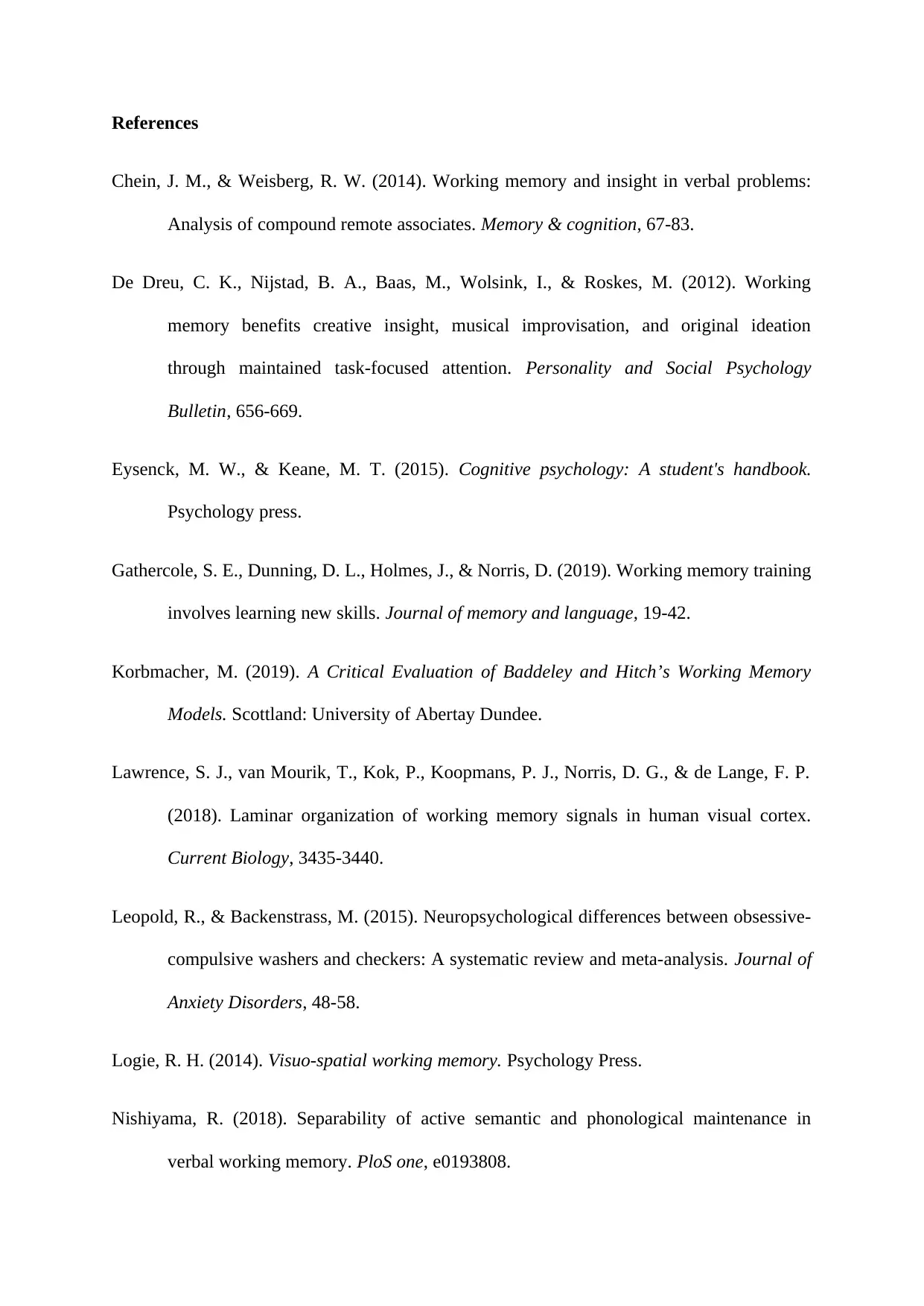Critical Evaluation of Short-Term Memory in Cognitive Psychology
VerifiedAdded on 2022/09/09
|11
|2785
|12
Essay
AI Summary
This essay provides a comprehensive critical evaluation of the Working Memory Model (WMM) in cognitive psychology, focusing on the contributions of Baddeley and Hitch. It delves into the core components of the WMM, including the central executive, phonological loop, visual-spatial sketchpad, and episodic buffer, analyzing their roles and interrelations. The essay examines the model's strengths in explaining short-term memory processes, multitasking, and learning, while also critically assessing its limitations. It discusses challenges in applying the model, such as the lack of detailed explanations for the central executive, the exclusion of emotional and motivational factors, and the under-investigation of the visual-spatial sketchpad. The essay also reviews the model's applicability to different age groups, its reliance on theoretical examples, and the impact of controlled environments on learning. Furthermore, it explores criticisms related to the phonological loop, visuospatial sketchpad, and central executive, concluding with an overview of the episodic buffer. The essay highlights the model's theoretical contributions while acknowledging its practical limitations and the need for further research to refine and expand the WMM.

Coginitive Psychology
Critical Evaluation
SystemJP
Critical Evaluation
SystemJP
Paraphrase This Document
Need a fresh take? Get an instant paraphrase of this document with our AI Paraphraser

Introduction
Working memory also known as recent or short term memory, created for the very short
period during the learning process, short memory is created and used with the pre-storage
long term memory for some task in the present time. Baddeley and Hitch presented the theory
of Short-Term Memory in 1974 to support the Multi-Store Ideal developed by the Atikinson
and Shiffirn in 1968, STM is one-time supporting memory defining human psychology to
give value what one needs in the present instead of storing may types of learning in mind
because multiple storage have high risk of getting confused at the time of evaluation of
proper knowledge (Chein & Weisberg, 2014). This essay will evaluate the findings, uses and
application of STM concept in the human life and impact of STM and MSM on their learning
process. This essay will review many articles discussing the role of STM in the human
psychology in different ages and in different stages of challenges from his childhood to his
young age. A human never stop learning and this process keep them eager to sharpen their
memory about the new things hence with the development and changes human psychology
towards learning and memorising is also changing and this can be understood from the
following discussion based on deep analysis of pieces of literature and articles.
“Working Memory: Challenges in application, positive and negative”
Working memory is linked to interface between learning, attention, perception and procedure
to perform a task and many target-oriented activities. Model of working memory include
multitasking activities and learning components, developed to remove the hurdles occurred
due to simple process of MSM, there is very few but very strong empirical research evidence
available in the articles and literature that support the most useful elements of the working
memory model first is the Central Executive (CE) and other is the Episodic Buffer. An
enhanced approach of the MSM model is the working theory model. After identification of
the STM model working memory becomes diversified into four factors, they were
Working memory also known as recent or short term memory, created for the very short
period during the learning process, short memory is created and used with the pre-storage
long term memory for some task in the present time. Baddeley and Hitch presented the theory
of Short-Term Memory in 1974 to support the Multi-Store Ideal developed by the Atikinson
and Shiffirn in 1968, STM is one-time supporting memory defining human psychology to
give value what one needs in the present instead of storing may types of learning in mind
because multiple storage have high risk of getting confused at the time of evaluation of
proper knowledge (Chein & Weisberg, 2014). This essay will evaluate the findings, uses and
application of STM concept in the human life and impact of STM and MSM on their learning
process. This essay will review many articles discussing the role of STM in the human
psychology in different ages and in different stages of challenges from his childhood to his
young age. A human never stop learning and this process keep them eager to sharpen their
memory about the new things hence with the development and changes human psychology
towards learning and memorising is also changing and this can be understood from the
following discussion based on deep analysis of pieces of literature and articles.
“Working Memory: Challenges in application, positive and negative”
Working memory is linked to interface between learning, attention, perception and procedure
to perform a task and many target-oriented activities. Model of working memory include
multitasking activities and learning components, developed to remove the hurdles occurred
due to simple process of MSM, there is very few but very strong empirical research evidence
available in the articles and literature that support the most useful elements of the working
memory model first is the Central Executive (CE) and other is the Episodic Buffer. An
enhanced approach of the MSM model is the working theory model. After identification of
the STM model working memory becomes diversified into four factors, they were

phonological loop, the visual-spatial sketchpad, the central executive and the episodic buffer
(De Dreu, Nijstad, Baas, Wolsink, & Roskes, 2012).
Third and new concept, central executive holds the super functioning position in the model
and it holds the phonological loop, the visual-spatial sketchpad under slavery concept,
Baddeley support his model by arguing upon better arrangement by the co-ordination among
other parts and elements of the cognitive system, but he failed to provide and concise and
detailed explanation of the central executive elements and system. Although this model
separately clarifies the roles and importance of all four elements they all are assumed the
same during their investigation of the whole working memory (Eysenck & Keane, 2015).
Baddeley introduced the central executive as the major element but it fails to define the most
driving and supporting element in the whole framework. In the learning of detailed and deep
analysis, STM model found unable to meet the multiple demands of human psychology in the
task and long-run workings (Korbmacher, 2019).
Amygdala in a human responses the emotional attachment with the learning and a person
involved in the motivational learning is critical to manage and control by STM model,
Baddeley failed to include the cognitive and motivational emotions in the framework
(Korbmacher, 2019). This is a most serious issue because human have a natural phenomenon
to get attracted towards better learning if it is emotionally attracted to them. Loss to the
amygdala can affect the learning involvement and attachment and furthermore, amygdala
have a magnetic energy to attract and distract human’s emotional attachment towards
something hence to neuropsychological development in a person is essential to apply the
working memory in his behaviour (Leopold & Backenstrass, 2015). Baddeley support the
emotional support but emotion in brain are not enough to learn but a man needs to interact
and apply the emotional attachment with the challenges and working culture to get the better
(De Dreu, Nijstad, Baas, Wolsink, & Roskes, 2012).
Third and new concept, central executive holds the super functioning position in the model
and it holds the phonological loop, the visual-spatial sketchpad under slavery concept,
Baddeley support his model by arguing upon better arrangement by the co-ordination among
other parts and elements of the cognitive system, but he failed to provide and concise and
detailed explanation of the central executive elements and system. Although this model
separately clarifies the roles and importance of all four elements they all are assumed the
same during their investigation of the whole working memory (Eysenck & Keane, 2015).
Baddeley introduced the central executive as the major element but it fails to define the most
driving and supporting element in the whole framework. In the learning of detailed and deep
analysis, STM model found unable to meet the multiple demands of human psychology in the
task and long-run workings (Korbmacher, 2019).
Amygdala in a human responses the emotional attachment with the learning and a person
involved in the motivational learning is critical to manage and control by STM model,
Baddeley failed to include the cognitive and motivational emotions in the framework
(Korbmacher, 2019). This is a most serious issue because human have a natural phenomenon
to get attracted towards better learning if it is emotionally attracted to them. Loss to the
amygdala can affect the learning involvement and attachment and furthermore, amygdala
have a magnetic energy to attract and distract human’s emotional attachment towards
something hence to neuropsychological development in a person is essential to apply the
working memory in his behaviour (Leopold & Backenstrass, 2015). Baddeley support the
emotional support but emotion in brain are not enough to learn but a man needs to interact
and apply the emotional attachment with the challenges and working culture to get the better
⊘ This is a preview!⊘
Do you want full access?
Subscribe today to unlock all pages.

Trusted by 1+ million students worldwide

outcomes in the activities theory of the emotion is not useful until applied in the basic
attachment and interaction (Logie, 2014).
Verbal short term memory is a temporary storage and is supported by many supporters
advocating verbal memory as the active rehearsal system working to improve phonological
storage through regular active involvement in world listing and many kinds of speech affect
the short memory (Stenbäck, 2016). Arguments are presented in the support of multi-
component model because it includes a clear difference between storage and processing with
distinct structures, a clear relation between the central executive and other elements is
difficult to identify in the STM model (Chein & Weisberg, 2014).
Working memory model is found more authentic in theoretical learning process, it faces
challenges in verbal learning because length of words is sometimes high and
neuropsychological element of human in phonological loop and the visual-spatial sketchpad
allows the learning in the verbal with the short length words, expect these MTM model has
more psychologically developed features that supports memory storage and uses (De Dreu,
Nijstad, Baas, Wolsink, & Roskes, 2012).
Many studies are available which are purely related to the phonological loop and storage and
assuming the phonological loop as the centre of the Working Memory model but the visual-
spatial sketchpad is seemed as the under-investigated, visual imaginary and Visio spatial
information can be stored in a place and used for a long time to interact with the spot in
neuropsychological literature and learning. Moreover any damage to the human brain and
memory directly affect the visual imaginary storage as well (Stenbäck, 2016). Use of the
visual interface by application of the visual-spatial sketch as the necessity with two
supporting elements of the Working Memory model in reaching to the stage of learning and
storage but Baddeley had not included the use and importance of visual-spatial sketchpad for
attachment and interaction (Logie, 2014).
Verbal short term memory is a temporary storage and is supported by many supporters
advocating verbal memory as the active rehearsal system working to improve phonological
storage through regular active involvement in world listing and many kinds of speech affect
the short memory (Stenbäck, 2016). Arguments are presented in the support of multi-
component model because it includes a clear difference between storage and processing with
distinct structures, a clear relation between the central executive and other elements is
difficult to identify in the STM model (Chein & Weisberg, 2014).
Working memory model is found more authentic in theoretical learning process, it faces
challenges in verbal learning because length of words is sometimes high and
neuropsychological element of human in phonological loop and the visual-spatial sketchpad
allows the learning in the verbal with the short length words, expect these MTM model has
more psychologically developed features that supports memory storage and uses (De Dreu,
Nijstad, Baas, Wolsink, & Roskes, 2012).
Many studies are available which are purely related to the phonological loop and storage and
assuming the phonological loop as the centre of the Working Memory model but the visual-
spatial sketchpad is seemed as the under-investigated, visual imaginary and Visio spatial
information can be stored in a place and used for a long time to interact with the spot in
neuropsychological literature and learning. Moreover any damage to the human brain and
memory directly affect the visual imaginary storage as well (Stenbäck, 2016). Use of the
visual interface by application of the visual-spatial sketch as the necessity with two
supporting elements of the Working Memory model in reaching to the stage of learning and
storage but Baddeley had not included the use and importance of visual-spatial sketchpad for
Paraphrase This Document
Need a fresh take? Get an instant paraphrase of this document with our AI Paraphraser

the blind people, but these people have a great spatial awareness that support their imaginary
power as well (Eysenck & Keane, 2015).
Central executive defined by the Baddeley as the key component after phonological loop, and
the visual-spatial sketchpad but he failed to define the functions performed by the central
executive (Lawrence, van Mourik, Kok, Koopmans, Norris, & de Lange, 2018). In the overall
process of the new STM model, while adapting it into a working memory concept in the field
of neuropsychological development of the human brain and visual imaginary life. Very little
evidence is presented in the model that support and define the role of central executive and
what exactly it dines in the overall process of learning (Korbmacher, 2019).
Child age is the most developing and learning phase of human development, adapting the v
phonological loop, the visual-spatial sketchpad and attachment with the learning is very
important at this age, Children learn things for a very short period and Working Memory
model failed to explain the role of STM model in the process of learning stage in a child,
changes in the learning method and visual representation affect the storage and uses of
memory but it fails to define the changes and their impact on the amygdala in human
psychology (Lawrence, van Mourik, Kok, Koopmans, Norris, & de Lange, 2018). Mccgan in
2008 defined a big lacking phase of the Working Memory Model is that it defines the
adaption and application of the model in the experiments done in the fictional and imaginary
environment, it excludes the involvement of any real-life example or illustration performed in
the reality, hence it has no particular relationship with the world and environment but only
some theoretical writings supporting the imaginary examples are used by the Baddeley and
Hitch to define the whole concept of neuropsychological behaviour of learning in the human.
Strict environment is assumed as the idol situation for the learning and same was done with
the concept and examples, but this is not an idol theory as it doesn’t support and involve the
naturalistic environment for the experiment and learning (Logie, 2014).
power as well (Eysenck & Keane, 2015).
Central executive defined by the Baddeley as the key component after phonological loop, and
the visual-spatial sketchpad but he failed to define the functions performed by the central
executive (Lawrence, van Mourik, Kok, Koopmans, Norris, & de Lange, 2018). In the overall
process of the new STM model, while adapting it into a working memory concept in the field
of neuropsychological development of the human brain and visual imaginary life. Very little
evidence is presented in the model that support and define the role of central executive and
what exactly it dines in the overall process of learning (Korbmacher, 2019).
Child age is the most developing and learning phase of human development, adapting the v
phonological loop, the visual-spatial sketchpad and attachment with the learning is very
important at this age, Children learn things for a very short period and Working Memory
model failed to explain the role of STM model in the process of learning stage in a child,
changes in the learning method and visual representation affect the storage and uses of
memory but it fails to define the changes and their impact on the amygdala in human
psychology (Lawrence, van Mourik, Kok, Koopmans, Norris, & de Lange, 2018). Mccgan in
2008 defined a big lacking phase of the Working Memory Model is that it defines the
adaption and application of the model in the experiments done in the fictional and imaginary
environment, it excludes the involvement of any real-life example or illustration performed in
the reality, hence it has no particular relationship with the world and environment but only
some theoretical writings supporting the imaginary examples are used by the Baddeley and
Hitch to define the whole concept of neuropsychological behaviour of learning in the human.
Strict environment is assumed as the idol situation for the learning and same was done with
the concept and examples, but this is not an idol theory as it doesn’t support and involve the
naturalistic environment for the experiment and learning (Logie, 2014).

Involving human in working memory activity in a strict and restricted environment affect the
emotions, motivation and cognitive behaviour during learning and adapting hypothesis of
neuropsychological behaviour, naturalistic environment without any outer control make the
learning easy for response in the development. Psychologist Domaiso defined in his Somatic
marker hypothesis to define the role of central executive with the use of phonological loop,
the visual-spatial sketchpad, this hypothesis question about the driving forces that cause the
emotion in human towards the cognitive learning and development, this hypothesis discusses
the case of Cage facing the issue in adapting and decision making. Working Memory Model
involves the overall concept of memory models used in the neuropsychological development
of human behaviour and it also includes practical definition like meta-analysis of brain injury
are assumed to hold low-memory storage, difficulty with the Phonological loop (Stenbäck,
2016).
Working Memory model is theoretically supportive but it has lacked on describing and
defining the application of the original framework as this framework is not applicable and
suitable to adopt in the naturalistic laboratories, controlled behaviour affects the emotions in
negative manner and also the linking concept of the Short Term Learning with the Long
Term memory (Gathercole, Dunning, Holmes, & Norris, 2019). Phonological Loop, inner
voice is assumed to hold and regulate the speech-based information, the visual-spatial
sketchpad imaginary visual representations affect the storage of the speech with the
imagination, both acquire the knowledge and new leanings, these are theoretically defined but
the most important element in the learning including the role of episodic Buffer is not
supported with the evidence of proper storage and connecting link between the short-term as
well as long-term retention(Eysenck & Keane, 2015).
emotions, motivation and cognitive behaviour during learning and adapting hypothesis of
neuropsychological behaviour, naturalistic environment without any outer control make the
learning easy for response in the development. Psychologist Domaiso defined in his Somatic
marker hypothesis to define the role of central executive with the use of phonological loop,
the visual-spatial sketchpad, this hypothesis question about the driving forces that cause the
emotion in human towards the cognitive learning and development, this hypothesis discusses
the case of Cage facing the issue in adapting and decision making. Working Memory Model
involves the overall concept of memory models used in the neuropsychological development
of human behaviour and it also includes practical definition like meta-analysis of brain injury
are assumed to hold low-memory storage, difficulty with the Phonological loop (Stenbäck,
2016).
Working Memory model is theoretically supportive but it has lacked on describing and
defining the application of the original framework as this framework is not applicable and
suitable to adopt in the naturalistic laboratories, controlled behaviour affects the emotions in
negative manner and also the linking concept of the Short Term Learning with the Long
Term memory (Gathercole, Dunning, Holmes, & Norris, 2019). Phonological Loop, inner
voice is assumed to hold and regulate the speech-based information, the visual-spatial
sketchpad imaginary visual representations affect the storage of the speech with the
imagination, both acquire the knowledge and new leanings, these are theoretically defined but
the most important element in the learning including the role of episodic Buffer is not
supported with the evidence of proper storage and connecting link between the short-term as
well as long-term retention(Eysenck & Keane, 2015).
⊘ This is a preview!⊘
Do you want full access?
Subscribe today to unlock all pages.

Trusted by 1+ million students worldwide

Major drawbacks presented as elements of Working Memory, Model of Baddeley and Hitch
can be discussed as;
A learning by Baddeley, recommended Phonological loop helping to obtain fresh words, like
foreign language, but it doesn’t include the linking of the familiar words, word-length effect
(WLE) represents that small words are easy to learn and memorise on other hand
phonological similarities effect (PSE) is the discovery that sequential recollection
accurateness drops the additional parallel items comprehensiveness. Furthermore, it is
uncertain whether aural or articulatory connections inspire PSE. In spite of bulky source with
the proof meant for WLE, WLE’s fundamental procedures and significance to sustenance PL
as separate subsystem persist debated Jalbert and colleagues (2011) claim for WLE only
presented as influence on orthographic zone and McGill (2019) originates an inverted WLE.
Generally, WMM does not satisfactorily define different evidence administered by PL and
prerequisites additional specification to permit follow-up investigation and study (Leopold &
Backenstrass, 2015).
Visuospatial sketchpad is assumed as the inner eye to imagine and link the spoken words
with pictures but Baddeley did not use proper explanation to connect the association of visual
and spatial memory. After studying the writings and collected works on oral and visuo-spatial
headlong besides regressive reminiscence, Donolato, and Mammarella debate that Working
Memory model is not evidently maintained by investigational proof. Besides it, the
beginnings of diverse mind zones throughout spatial and pictorial dispensation will
recommend diversity of VC and IS. Hence, more investigation is required to indicate if any
specific brain areas remain active on continue basis during the process of visuospatial
learning and more research about the processing with evidence during the visual store and
internal inscribe required to understand the integration of vision and speech in the human
brain (Nishiyama, 2018).
can be discussed as;
A learning by Baddeley, recommended Phonological loop helping to obtain fresh words, like
foreign language, but it doesn’t include the linking of the familiar words, word-length effect
(WLE) represents that small words are easy to learn and memorise on other hand
phonological similarities effect (PSE) is the discovery that sequential recollection
accurateness drops the additional parallel items comprehensiveness. Furthermore, it is
uncertain whether aural or articulatory connections inspire PSE. In spite of bulky source with
the proof meant for WLE, WLE’s fundamental procedures and significance to sustenance PL
as separate subsystem persist debated Jalbert and colleagues (2011) claim for WLE only
presented as influence on orthographic zone and McGill (2019) originates an inverted WLE.
Generally, WMM does not satisfactorily define different evidence administered by PL and
prerequisites additional specification to permit follow-up investigation and study (Leopold &
Backenstrass, 2015).
Visuospatial sketchpad is assumed as the inner eye to imagine and link the spoken words
with pictures but Baddeley did not use proper explanation to connect the association of visual
and spatial memory. After studying the writings and collected works on oral and visuo-spatial
headlong besides regressive reminiscence, Donolato, and Mammarella debate that Working
Memory model is not evidently maintained by investigational proof. Besides it, the
beginnings of diverse mind zones throughout spatial and pictorial dispensation will
recommend diversity of VC and IS. Hence, more investigation is required to indicate if any
specific brain areas remain active on continue basis during the process of visuospatial
learning and more research about the processing with evidence during the visual store and
internal inscribe required to understand the integration of vision and speech in the human
brain (Nishiyama, 2018).
Paraphrase This Document
Need a fresh take? Get an instant paraphrase of this document with our AI Paraphraser

Working Memory Model is central managing between the different components of the model,
Hence, difficulties with CE may be related to the complications in exchanging among altered
WMM-components. Challengingly, both environment and occurrence of procedures
including CE stay uncertain and similarly these are not explained in WMM hence
experimentations detecting CE are in encrustation of task-impurity-problem and made the
model very challenging in reorganization to Central Executive’s particular assistances and
contributions (Gathercole, Dunning, Holmes, & Norris, 2019).
Working Memory model indicates its new feature Episodic Buffer is explained as the holding
component of all three elements, allowing the temporary storage to form long term memory
is critically difficult to understand in context of its process of using, storing ad interacting
between the different models to frame a proper structure, and it fails to clarify the managing
process and to provide more relevant evidence for the effective working of WM model
(Logie, 2014).
Conclusion
This report represents the positive aspect introduced in the Working Memory Model and also
critically evaluates this model with the help of different researches and presentation paper.
This innovation by Baddeley enhanced the criteria but put many challenges in understanding
the real concept. People engaged in critical and challenging tasks use short term learning
memory to deal the functions properly and connect their thoughts with the long term learning,
but this memory is useful for the instant action because people are not able to learn this
memory for long term challenges because they don’t learn it for the long run issues but they
use it for their instant and short-run tasks with mutual connection. Working Model of
Baddeley and Hitch is new ad developed model defining psychological elements affecting the
cognitive behaviour of Shirt term and Long term memory, concept defines theoretical and
practical examples of Working Memory but lack of proper evidence and illustration about the
Hence, difficulties with CE may be related to the complications in exchanging among altered
WMM-components. Challengingly, both environment and occurrence of procedures
including CE stay uncertain and similarly these are not explained in WMM hence
experimentations detecting CE are in encrustation of task-impurity-problem and made the
model very challenging in reorganization to Central Executive’s particular assistances and
contributions (Gathercole, Dunning, Holmes, & Norris, 2019).
Working Memory model indicates its new feature Episodic Buffer is explained as the holding
component of all three elements, allowing the temporary storage to form long term memory
is critically difficult to understand in context of its process of using, storing ad interacting
between the different models to frame a proper structure, and it fails to clarify the managing
process and to provide more relevant evidence for the effective working of WM model
(Logie, 2014).
Conclusion
This report represents the positive aspect introduced in the Working Memory Model and also
critically evaluates this model with the help of different researches and presentation paper.
This innovation by Baddeley enhanced the criteria but put many challenges in understanding
the real concept. People engaged in critical and challenging tasks use short term learning
memory to deal the functions properly and connect their thoughts with the long term learning,
but this memory is useful for the instant action because people are not able to learn this
memory for long term challenges because they don’t learn it for the long run issues but they
use it for their instant and short-run tasks with mutual connection. Working Model of
Baddeley and Hitch is new ad developed model defining psychological elements affecting the
cognitive behaviour of Shirt term and Long term memory, concept defines theoretical and
practical examples of Working Memory but lack of proper evidence and illustration about the

experiments make it very complex to understand in the regular behaviour of Working
memory.
memory.
⊘ This is a preview!⊘
Do you want full access?
Subscribe today to unlock all pages.

Trusted by 1+ million students worldwide

References
Chein, J. M., & Weisberg, R. W. (2014). Working memory and insight in verbal problems:
Analysis of compound remote associates. Memory & cognition, 67-83.
De Dreu, C. K., Nijstad, B. A., Baas, M., Wolsink, I., & Roskes, M. (2012). Working
memory benefits creative insight, musical improvisation, and original ideation
through maintained task-focused attention. Personality and Social Psychology
Bulletin, 656-669.
Eysenck, M. W., & Keane, M. T. (2015). Cognitive psychology: A student's handbook.
Psychology press.
Gathercole, S. E., Dunning, D. L., Holmes, J., & Norris, D. (2019). Working memory training
involves learning new skills. Journal of memory and language, 19-42.
Korbmacher, M. (2019). A Critical Evaluation of Baddeley and Hitch’s Working Memory
Models. Scottland: University of Abertay Dundee.
Lawrence, S. J., van Mourik, T., Kok, P., Koopmans, P. J., Norris, D. G., & de Lange, F. P.
(2018). Laminar organization of working memory signals in human visual cortex.
Current Biology, 3435-3440.
Leopold, R., & Backenstrass, M. (2015). Neuropsychological differences between obsessive-
compulsive washers and checkers: A systematic review and meta-analysis. Journal of
Anxiety Disorders, 48-58.
Logie, R. H. (2014). Visuo-spatial working memory. Psychology Press.
Nishiyama, R. (2018). Separability of active semantic and phonological maintenance in
verbal working memory. PloS one, e0193808.
Chein, J. M., & Weisberg, R. W. (2014). Working memory and insight in verbal problems:
Analysis of compound remote associates. Memory & cognition, 67-83.
De Dreu, C. K., Nijstad, B. A., Baas, M., Wolsink, I., & Roskes, M. (2012). Working
memory benefits creative insight, musical improvisation, and original ideation
through maintained task-focused attention. Personality and Social Psychology
Bulletin, 656-669.
Eysenck, M. W., & Keane, M. T. (2015). Cognitive psychology: A student's handbook.
Psychology press.
Gathercole, S. E., Dunning, D. L., Holmes, J., & Norris, D. (2019). Working memory training
involves learning new skills. Journal of memory and language, 19-42.
Korbmacher, M. (2019). A Critical Evaluation of Baddeley and Hitch’s Working Memory
Models. Scottland: University of Abertay Dundee.
Lawrence, S. J., van Mourik, T., Kok, P., Koopmans, P. J., Norris, D. G., & de Lange, F. P.
(2018). Laminar organization of working memory signals in human visual cortex.
Current Biology, 3435-3440.
Leopold, R., & Backenstrass, M. (2015). Neuropsychological differences between obsessive-
compulsive washers and checkers: A systematic review and meta-analysis. Journal of
Anxiety Disorders, 48-58.
Logie, R. H. (2014). Visuo-spatial working memory. Psychology Press.
Nishiyama, R. (2018). Separability of active semantic and phonological maintenance in
verbal working memory. PloS one, e0193808.
Paraphrase This Document
Need a fresh take? Get an instant paraphrase of this document with our AI Paraphraser

Stenbäck, V. (2016). Speech masking speech in everyday communication: The role of
inhibitory control and working memory capacity. Linköping University Electronic
Press.
inhibitory control and working memory capacity. Linköping University Electronic
Press.
1 out of 11
Related Documents
Your All-in-One AI-Powered Toolkit for Academic Success.
+13062052269
info@desklib.com
Available 24*7 on WhatsApp / Email
![[object Object]](/_next/static/media/star-bottom.7253800d.svg)
Unlock your academic potential
© 2024 | Zucol Services PVT LTD | All rights reserved.





